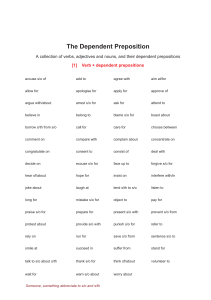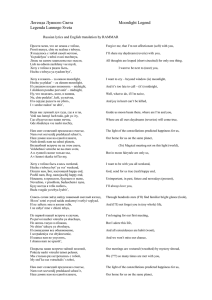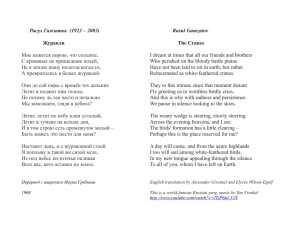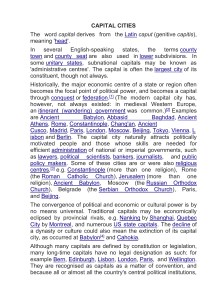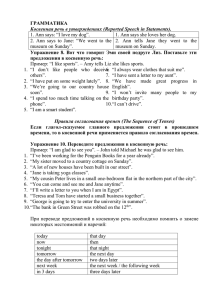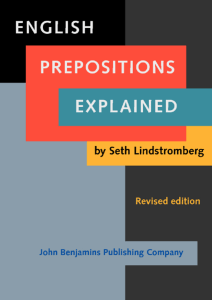ПРЯМАЯ И КОСВЕННАЯ ДИАТЕЗА МЕНТАЛЬНОГО ГЛАГОЛА
advertisement
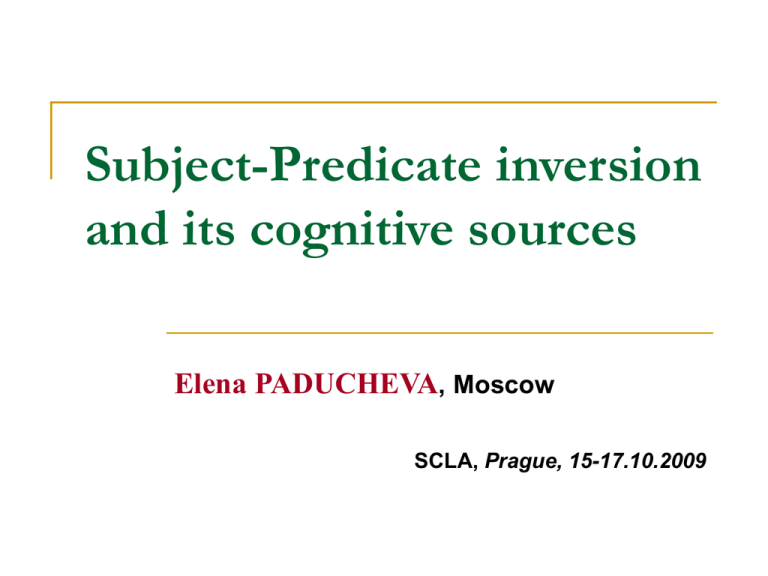
Subject-Predicate inversion and its cognitive sources Elena PADUCHEVA, Moscow SCLA, Prague, 15-17.10.2009 0. Subject-Predicate Inversion In Russian, moving a word or a constituent from the end of a sentence to its beginning usually triggers off the inversion of the word order in the remaining Subject-Predicate combination. Examples (0.1) а. Высокая шапка была надвинута на глаза; b. На глаза была надвинута высокая шапка. (0.2) а. Реферативный журнал помогает специалисту сэкономить время; b. Сэкономить время помогает специалисту реферативный журнал. (0.3) а. Вода делает в пустыне подлинные чудеса; b. Подлинные чудеса делает в пустыне вода. LA-structure The word order is to be regarded as inseparable from prosody, i.e. from the placement of phrasal accent and its type (raising or falling). Hence the notion of linear-intonational, or linearaccentual structure of a sentence (“linejnoakcentnaja structura”), LA-structure (see Падучева 1985/2008, Янко 2001). LA-structure contains both types of information, i.e. both word order and phrasal accents. Example If we change the word order in sentence (0.4a) we can get sentence (0.4b) with a different word order but with practically the same meaning, because the word речь, which changes its place, preserves its accent: (0.4) a. О чем / | идет речь \ ? b. О чем / | речь \ идет? Slash / denotes the raising tone, back slash \ represents the falling tone; the vertical line | shows the border between the LA-structure components. 1. LA-structure and its transformations The LA-structure is the signifiant for the Theme-Rheme-structure (= Topic-Focus Articulation = communicative structure = information structure) of a sentence. Semantic relationships between a- and bsentences in examples (0.1) – (0.3) can be accounted for by shifts, which are applied to their LA-structures (about LA-shifts see Ковтунова 1976, Падучева 1985/2008: 108119, Янко 2001, Циммерлинг 2007). The following two shifts are in the scope of attention: 1) expressive preposition, i.e. fronting of a constituent preserving the falling phrasal accent customary for the end of a sentence, as in (0.3а); 2) thematic preposition, i.e. fronting of a constituent with a change of the intonation contour: the fronted constituent loses its rhematic falling accent and acquires the thematic raising one, as in (0.1b), (0.2b). Both movements tend to be accompanied by Subject-Predicate inversion. On Locative inversion in English see Levin & Rappaport Hovav 1995: 218-277 In Russian, SP-inversion is not limited to fronting of a locative constituent: various types of constituents display the same kind of behavior. The subject itself can be fronted. In this case inversion concerns some other parts of the sentence, e.g., object and predicate (Ковтунова 1976: 173175). (1.1) а. Ивана охватила ярость \ b. Ярость \ охватила Ивана Some assumptions important for what follows I. A sentence can be presented on a lexico-syntactic level as a lineary ordered set of word forms provided with a dependency tree. This representation is sufficient to build a constituent structure of the sentence, see Гладкий 1973. What is called the word order is, basically, the order of constituents. II. A sentence with a given lexico-syntactic structure has a basic (initial, neutral) LA-structure corresponding to it. All the rest LA-structures of the sentence can be looked upon as derived from the initial LA-structure with the help of LA-shifts, each shift contributing to the informational structure of the sentence. 2. Expressive preposition Only those sentences are taken into consideration in which the Rheme consists of a verb and its dependent NP or PP, which is the rhematic center of the Rheme (Падучева 1985/2008: 112), or the accent bearer (in terms of Янко 2001, where this notion is thoroughly examined). For example, in (2.1a) пахнет махоркой is the Rheme, махоркой is the accent bearer: (2.1) а. Этот мешок пахнет махоркой \ b. Махоркой \ пахнет этот мешок _ Other examples of expressive preposition: (2.2) а. Ребенок требует любви и заботы \ b. Любви и заботы \ требует ребенок (2.3) а. Споры были жаркие \ b. Жаркие \ были споры (2.4) а. Комната наполнилась запахом осени \ b. Запахом осени \ наполнилась комната (2.5) а. Этот вопрос вставал передо мною не однажды \ b. Не однажды \ вставал передо мною этот вопрос SP-inversion in transitive sentences The main bulk of sentences that undergo fronting accompanied by SP-inversion are intransitive. In a transitive sentence SPinversion is also possible (Циммерлинг 2007), but it is much less obligatory: (2.6) а. Золушка мыла посуду на кухне \ b. На кухне \ мыла посуду Золушка_ с. На кухне \ Золушка мыла посуду_ The semantic effect of the expressive preposition escapes strict definition. 3. Thematic preposition Thematic preposition consists in that the constituent which in its “previous” final position carried the rhematic falling tone not only changes its place (now occupying the initial position in the sentence) but also acquires the thematic, i.e. raising accent. The LA-structure changes significantly, and so does the TR-structure. Examples. (3.1) а. Мой брат / | живет в Казани \ b. В Казани / | живет мой брат \ (3.2) а. Утки / | плавают в пруду \ b. В пруду / | плавают утки \ (3.3) а. Коля / | пришел на рассвете \ b. На рассвете / | пришел Коля \ (3.4) а. Собака / | укусила мальчика \ b. Мальчика / | укусила собака \ (3.5) а. Профессор Иванов / | посетил лабораторию Завадовского\ б. Лабораторию Завадовского / | посетил профессор Иванов \ . (3.6) а. Объект / | выражается аккузативом \ b. Аккузативом / | выражается объект \ In the examples (3.1)–(3.6) In the a-sentences the subject phrase (“gruppa podlezhashchego”) is the Theme, the predicate phrase (“gruppa skazuemogo”) is the Rheme; the Rheme is divisible into a verb and an NP, PP or Adjective phrase – the accent bearer. In the b-sentences the accent bearer of the asentence becomes the Theme, while the remnants of the sentence, namely, the subject and what is left of the initial Rheme constitute the new Rheme. The syntactic type of the fronted constituent is irrelevant: The syntactic type of the fronted constituent varies: it can be a Locative, a Time adverbial, a Direct object, an Instrumental object, an Adjective phrase, etc. Subject-Predicate inversion in (3.1) – (3.6) is almost obligatory. SP-inversion is strictly obligatory in interrogative sentences and in relative clauses. In (3.7), (3.8) SP-inversion is triggered by grammatically determined movement of the constituent from its natural final position to the beginning of the sentence or clause. (3.7) а. Речь идет о зарплате \ b. О чем идет речь \ ? [interrogative sentence] с. *О чем речь идет \ ? (3.8) а. Собака укусила мальчика; b. Это мальчик, которого укусила собака \ [relative clause] с. *Это мальчик, которого собака укусила \ A similar kind of inversion takes place in subjectless sentences (3.9) а. Не удалось / подобрать для нее подходящего партнера \ b. Подходящего партнера / подобрать для нее не удалось \ (3.10) а. Нельзя / пускать туда детей \ b. Детей / | туда пускать нельзя \ (3.11) а. На немецком языке / | говорят в Австрии \ b. В Австрии / | говорят на немецком языке \ (example from Sgall, Hajičova 1977) Semantic contribution of the thematic preposition, example I (3.6) а. Объект / | выражается аккузативом \ b. Аккузативом / | выражается объект \ The final position of an NP provides it with definiteness; hence what is called exhaustive list interpretation: sentence (3.6a) means that the object (in the language in question) can be expressed only by the Accusative; i.e. that there are, e.g., no genitive objects in that language. While (3.6b) means that the Accusative marks only the direct object NPs (so that the language has, e.g., no accusativus tempori). Semantic contribution of the thematic preposition, example II Another example of the same kind is (3.11), a famous example from Sgall, Hajičova 1977: (3.11) а. На немецком языке / | говорят в Австрии \ b. В Австрии / | говорят на немецком языке \ Definitely, (3.11b) is true, while (3.11a) is false. The meaning difference between a- and b-sentences in (3.11) rests upon the fact that the NP in the rhematic position expresses identification. Sentence (3.11b) identifies the language spoken in Austria (and is true), while (3.11a) identifies the country that speaks German (and is false). 4. Cognitive motivation of SP-inversion In the frame of the syntactic approach to SPinversion the goal has been to find co-occurrence restrictions on SP-inversion. For example, in Levin & Rappaport Hovav 1995 the task was to find lexical and syntactic limitations on SP-inversion conditioned by fronting of a locative phrase. My goal is to find cognitive sources of SP-inversion that accompanies fronting of the rhematic constituent: what is it motivated by? For Russian, with its wide freedom of fronting and inversion, the overall picture is clearer than for languages with strict word order limitations, such as English. Integrated Rheme In an ordinary Russian sentence, with a prepositive subject, the subject NP is the Theme, the predicate is the Rheme, and the sentence has a two-component LAstructure, see (3.1). Thematic preposition of the Rhematic center creates a new Theme. And by default the old subject and the remnants of the old predicate VP unite into one integrated Rheme. In this way a sentence with a fronted constituent acquires a new binary (i.e. twocomponent) LA-structure: (3.1) а. Мой брат / | живет в Казани \ b. В Казани / | живет мой брат \ Integration of the two previously disconnected sentence parts is achieved with the help of the SP-inversion. The Nominative NP in the constituent-initial position contributes to disintegration of the newly born rhematic constituent, while SP-inversion, i.e. transferring of the Nominative NP into the final position, provides integration. In fact, it contributes to formation of a new Rheme as a united, i.e. integrated constituent. Subject NP in the constituent-initial position contributes to communicative disintegration of the constituent The final position of the subject NP contributes to communicative integration of the rhematic constituent, while the subject NP in the constituent-initial position contributes to disintegration. Нерасчлененные высказывания (Ковтунова 1976: 47) The notion of integrated Rheme (“neraschlenennaja rema”) is well known when applied to the sentence as a whole. In (4.1) a change of the word order (and accent) transfers a two-component TR-structure of a sentence into a TR-structure consisting of one integrated Rheme: (4.1) а. Весна наступила = [Весна]T [наступила]R b. Наступила весна = [Наступила весна]R. SP-inversion as an integrative device The integrative device which is at work on the level of a sentence in example (4.1b) is used on the level of a constituent of a sentence in examples (3.1b) – (3.6b). When the New Theme is already chosen, there are two possibilities for the remaining part of the sentence (i.e. the Old Theme + the remnants of the Old Rheme) – it can either be integrated into one rhematic TR-structure component or disintegrated into Theme and Rheme. In this second case we get a three-component TRstructure. Example (4.2) а. Хозяин дома / | открыл нам дверь \ b. Дверь / | открыл нам хозяин дома \ c. Дверь / | хозяин дома нам открыл \ Sentence (4.2b), with SP-inversion, exemplifies the familiar two-component LAstructure, the same as in (3.1b)–(3.6b). Meanwhile (4.2c), with the non-inverted word order, has a different LA-structure – and a different meaning. LA-structure and TR-structure TR-structures of (4.2b) and (4.2с) are represented as (#4.2b) and (#4.2с): (#4.2b) Дверь открыл нам хозяин дома = [Дверь]Т [открыл нам хозяин дома]R (#4.2с) Дверь хозяин дома нам открыл = [Дверь]T1 [хозяин дома]Т2 [нам открыл]R T1 and T2 in (#4.2c) are, correspondingly, Theme 1, and Theme 2. The NP дверь, Theme 1, becomes the focus of contrast; hence the implication that something else (e.g., the window) remained closed, which is absent in (#4.2b). See Падучева 1985: 118 on contrastive Theme and Янко 2001 on contrast in general. Other devices contributing to the integrity of the Rheme SP-inversion is only one of the set of devices that contribute to the integrity of the Rheme. In (4.3), (4.4) it is negation or some other rhematizing particle that provides a non-thematic fragment of the sentence with rhematic integrity. (4.3) а. Ваня / | не обладал даром предвидения \ b. Даром предвидения / | Ваня не обладал \ (4.4) а. Валя / | даже не посмотрела на ребенка \ b. На ребенка / | Валя даже не посмотрела \ Fronting of non-rhematic constituents SP-inversion doesn’t take place if a nonrhematic constituent is fronted: (4.5) а. Иван видел \ Марию _ b. Марию / | Иван видел \ What is left after fronting of the final NP in (4.5) is a constituent with an accent on the final word, i.e. a well formed Rheme. Context dependent LA-structures Slightly simplifying the issue we can assume that a sentence with the basic LA-structure is contextually independent. It answers a question “What has happened?” or “What is going on?”. While a sentence with the thematic preposition requires a special context – it may be a narrative context or a context of discourse. Example. (4.6) а. Коля / | подарил Васе попугая \ b. Попугая / | подарил Васе Коля \ Sentence (4.6a) is context independent, while (4.6b) may presuppose a question “Where has Vasja taken the parrot from?”. Example Sentence (4.7) («Наука и жизнь», 2009, №2, p. 9), could have been an answer to a question “What was Bakunin’s attitude towards the French revolution of 1848?”. (4.7) а. Французскую революцию 1848 года / | Бакунин горячо приветствовал \ . In fact, the LA-structure of this sentence is substantiated by its narrative context. Preposition of the direct object is due to the fact that the previous text concerned Bakunin’s attitude towards Polish rebellion of 1830 («… я горячо желаю торжества польскому восстанию») . Theme of the text The unambiguously thematic position of the subject Бакунин is explained by the fact that the article as a whole is devoted to Bakunin, so the subject Бакунин can occupy no other position but a thematic one. Otherwise the SP-inversion generating integrative Rheme would have been more than natural: (4.7) b. Французскую революцию 1848 года / | горячо приветствовал Бакунин \ Conclusion SP-inversion which accompanies, obligatorily or optionally, the fronting of a rhematic constituent in a Russian sentence remained a riddle of the Russian word order regularities for decades. The following explanation for this inversion is suggested. SubjectPredicate inversion is a device that makes it possible to overcome the communicative disintegration (i.e. potential Theme-Rheme divisibility) of a sentence fragment in which the Subject phrase precedes the Predicate phrase. References Гладкий 1973 – Гладкий А. В. Формальные грамматики и языки. М.: Наука, 1973 Ковтунова 1976 – Ковтунова И.И. Современный русский язык: Порядок слов и актуальное членение предложения. М., 1976. Падучева 1985/2008 – Падучева Е. В. Высказывание и его соотнесенность с действительностью. М.: Наука, 1985; 5-th edition – Moscow: URSS, 2008. Циммерлинг 2007 – Циммерлинг А.В. Локативная инверсия в языках со свободным порядком слов // Труды международной конференции Диалог 2007, 242-249. Янко 2001 – Янко Т. Е. Коммуникативные стратегии русской речи. М.: Языки славянской культуры, 2001. Янко 2008 – Янко Т. Е. Интонационные стратегии русской речи в сопоставительном аспекте. М.: Языки славянских культур, 2008 Levin & Rappaport Hovav 1995 – Levin B., Rappaport Hovav M. Unaccusativity: At the syntax-lexical semantics interface. Cambridge, Mass.: MIT Press, 1995. Спасибо за внимание!
